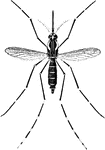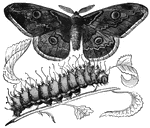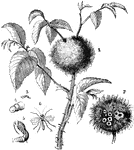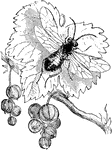
Mosquito
"A small two-winged fly, Culex pipiens, of the family Culicidae, suborder Nemocera, and order Diptera,…
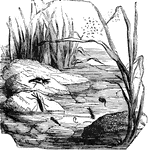
Mosquitos
"The Mosquitos, Colex musquito, which are very nearly allied to the gnats, are still greater…

Codlin Moth and Grub
Caterpillar, larvae of the moth and butterfly, are harmful to plants. These caterpillars sucker feet…

Cecropia Moth
"The Cecropia Moth, A. Cecropia, is of a dusky reddish-brown; the wings expand six inches,…
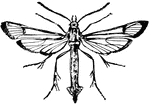
Clear-Winged Moth
"These are wasplike moths of brilliant colors and have transparent wings. They generally fly by day."…

Death's Head Moth
"The most remarkable species is the Death's Head Moth, Acherontia Atropos, a large kind,…

Female Gipsy Moth
Female gipsy moths have large wings that are covered with small scales. The mouth is not able to bite.…
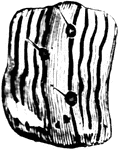
Eight-Spotted Forester
The adult Eight-Spotted Forester (Alypia octomaculata), a moth belonging to the Noctuidae family of…

Female Geometer Moth
The female Fidonia faxoni, an species from the Geometridae family of geometer moths.

Male Geometer Moth
The male Fidonia faxoni, an species from the Geometridae family of geometer moths.

European Grapevine Moth
The European Grapevine Moth (Lobesia botrana) is an insect in the Tortricidae family of tortrix moths.
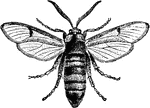
Hornet Moth
Also known as Sesia apiformis. A large moth with a striking imitation of a hornet. They are, however,…
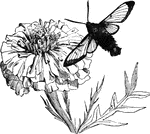
Hummingbird Moth
"A considerable number of insects belonging to Sphingina have transparents wings. Among them is the…

Imperial Moth
The Imperial Moth (Eacles imperialis) is an insect in the Saturniidae family of large and colorful moths.

Luna Moth
"Among the larger and more splendid moths of our own country is the Luna Moth, or Green Emperor Moth,…

Caterpillar of the Luna Moth
"Among the larger and more splendid moths of our own country is the Luna Moth, or Green Emperor Moth,…

Chrysalis of the Luna Moth
"Among the larger and more splendid moths of our own country is the Luna Moth, or Green Emperor Moth,…

Leaf Blotch Miner Moth
"Gracilaria salicifoliella. GRACILARIA. In entomology, the typical genus of Gracilariidae, containing…

Pine Beauty Moth
Pine beauty moth is the common name of trachea piniperda. This moth is a heavy bodied insect with variegated…

Plum Moth
"Plum-moth (Grapholitha prunivora). GRAPHOLITHA. A genus of small and peculiarly marked tortricid moths,…

Satellite Sphinx Moth
"Philampelus satellitia, a large and handsome hawk-moth whose larva feeds upon the vine. Natural size.…
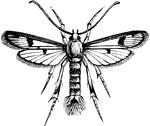
Sugar-Maple Moth
An illustration of a sugar-maple moth. A moth is an insect closely related to the butterfly, both being…
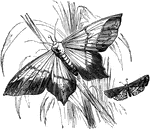
Swallow-Tailed Moth
The swallow-tailed moth (Ourapteryx sambucaria) and the many-plumed moth (Ourapteryx hexadactyla).
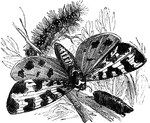
Tiger Moth
The garden tiger moth (Arctia caja) is named for the different and colorful patterns on its wings.
Nervous System of a Ladybug Larva
Nervous system of the larva of a ladybug. Labels: Gfr, frontal ganglion; G, cerebral ganglia; Sg, subcesophageal…

Nut Weevil and Grub
Nut weevil is the common name of balaninus nucum. The weevil is one third of an inch long with an egg…
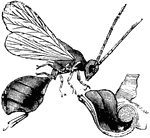
Oak Gall Fly
This picture shows the hinder rings of the abdomen and the ovipositor. The ovipositor serves to pierce…

Oak Galls
Galls are structures budded out from stems, leaves, or other pats of plants. Galls are made by insects…
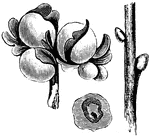
Oak Galls
Galls are structures budded out from stems, leaves, or other pats of plants. Galls are made by insects…

Larvae of Onion Fly
Pictured is a section of an onion attacked by the larvae of the onion fly. The burrow of the larva is…

Pollination of an Orchid
Also known as Orchis morio. A depiction of the pollination of an orchid, where a hive bee is sucking…
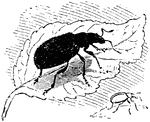
Phyllobius Oblongus
Phyllobius is a genus of small beetles. The oblongus variety has a short, thick beak. The antennae arise…

Phylloxera-mite
A phylloxera. Typically found in eastern North America, and related to the aphid, they typically feed…

Pissodes Notatus
Pissodes notatus is a pine weevil. Pictured is the insect and the ravages to a tree trunk committed…
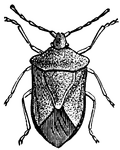
Plant-bug
Dotted leg plant-bug, one of many different heteropterous insects which suck the juices of plants.
!["The larvae of [Saperda populena] live in gall-like swellings in the branches [of poplar]."—Nicholson, 1884](https://etc.usf.edu/clipart/79000/79089/79089_populena_mth.gif)
Saperda Populena
"The larvae of [Saperda populena] live in gall-like swellings in the branches [of poplar]."—Nicholson,…

Potherb Moth
The hind wings of the potherb moth are frequently unspotted. The body is thick and heavy. The color…
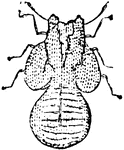
Larva of Psylla Pyrisuga
The larva of psylla pyrisuga live on pear trees and sometimes apple trees. The larvae suck the juice…

Blackberry Psyllid
The Blackberry Psyllid (Trioza tripunctata) is an insect that feeds on specific plants.

Pupa
Illustration of a pupa attached to a wall. A pupa (Latin pupa for doll, pl: pupae or pupas) is the life…

Pupa
Illustration of a pupa attached to a leaf. A pupa (Latin pupa for doll, pl: pupae or pupas) is the life…
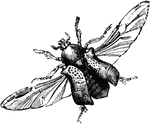
Rose Chafer with Hind Wings Extended
The body of the rose chafer is encased with a hard crust. The front wings are modified to form hard…
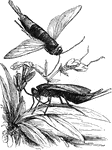
Sawfly
"On the continent of Europe the Sirex gigas often appears in immense numbers, and does great…

American Sawfly
The American Sawfly (Cimbex Americana) is an insect with an ovipositor resembling a saw blade.
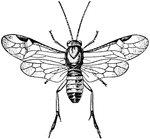
Larch Sawfly
The Larch Sawfly (Pristiphora erichsonii) is an insect resembling a black wasp in the Tenthredinidae…

Larvae of Rose Sawfly
A parasite which feeds as larvae in rose-twigs or upon the leaves. Some species are confined to roses…

